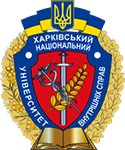Mathematics in police activity: basics, features, mathematical training
Abstract
The main attention is paid to the introduction of a comprehensive academic discipline “Mathematical Methods in Police Activity” for the first time and the discussion of the content of its first module for students of higher education institutions subordinated to the Ministry of Internal Affairs of Ukraine with the aim of combining mathematical methods, as well as elements of physics, astronomy and geography, in particular topography, to solve practical problems in the professional activity of police officers. Some components of the first module of this discipline are formulated on the basis of a study of an online course on mathematics for firefighters and rescuers in the United States.
The problem of introducing a course in mathematics or elements of applied mathematics (mathematics and methods of solving tasks for professional purposes) or applied mathematics with elements of natural science (an integrated course in astronomy, physics and geography) into the educational process of training future police officers has not been studied in a comprehensive manner. There are some recommendations on the expediency of studying statistics, but there are many branches of mathematics whose methodology is useful for solving applied problems in the fields of justice and law enforcement.
The need for such a study is due to the lack of a universal course for police officers in the world practice that would combine practical problem solving, mathematical methods, physical laws and processes, astronomy and geography, including topography.
The formulated components of the first module of the course are relatively complete in terms of content and form the knowledge necessary to develop the skills and abilities to perform elementary calculation professional tasks and to comply with and understand safety rules.
The article is the first in a series of articles on the relevant topic, some of which are in the process of preparation or are preprints.
Downloads
References
Dees, T. (2018). How do police officers use maths? [Comment on the online forum]. Quora. https://www.quora.com/How-does-a-law-enforcement-officer-use-math-in-his-daily-work.
Austin, K. (2018, December 30). How Is Math Used in Criminal Justice? CareerTrend. https://careertrend.com/how-does-4947627-how-math-used-criminal-justice.html.
Shane, H. (2019, January 14). How Are Math & Criminal Justice Related? CareerTrend. https://careertrend.com/about-5463177-math-criminal-justice-related.html.
Ramos, Chr. (2013, August 26). Using Math in Law Enforcement. Prezi. https://prezi.com/d7t3wncx2ghp/using-math-in-law-enforcement/.
Hughes, K. L., & Zoellner, J. (2019). Mathematics for criminal justice: Recommendations from professional organizations and sample requirements from institutions of higher education. https://dcmathpathways.org/sites/default/files/resources/2019-06/DCMP_issue_brief_criminal_justice_20190612.pdf.
Kolokolnikov, Th., Lloyd, D. J. B., & Short, M. (2019, March 17–22). Mathematical Criminology and Security. Banff International Research Station for Mathematical Innovation and Discovery. https://www.birs.ca/workshops/2019/19w5101/report19w5101.pdf.
Bertozzi, A. L. (2010). Mathematics of Crime. De Morgan House. http://www.ltcc.ac.uk/media/london-taught-course-centre/documents/Mathematics-of-Crime-.pdf.
Davies, T. (2018, June 26). The role of mathematics in crime science. UCL Discovery. https://discovery.ucl.ac.uk/id/eprint/10117102/1/mathematics_chapter_SUBMITTED.pdf.
Tambe, M. (2012). Security and game theory. Cambridge University Press.
Copyright (c) 2023 S. O. Serbenyuk

This work is licensed under a Creative Commons Attribution 4.0 International License.



